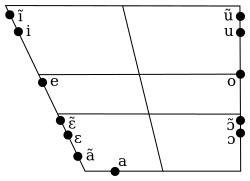Dangme language
| Dangme | |
|---|---|
| Dangme | |
| Region | South-eastern Ghana, east of Accra |
| Ethnicity | Dangme |
Native speakers | 800,000 (2004)[1] |
| Latin (Dangme alphabet) | |
| Official status | |
Official language in | Ghana |
| Language codes | |
| ISO 639-2 |
ada |
| ISO 639-3 |
ada |
| Glottolog |
adan1247[2] |
The Dangme language, Dangme or Adaŋgbi, is a Kwa language spoken in south-eastern Ghana by the Dangme People (Dangmeli). Dangmeli are part of larger Ga-Dangme ethnic group. Klogbi, is a variant of Adaŋgbi, spoken by Kloli (Klo or Krobo People)
Classification
Dangme is a Kwa language, part of the Niger–Congo family. It is very closely related to Ga, and together they form the Ga–Dangme branch within Kwa. It is also part of the Gbe language group,
Geographic distribution
Dangme is spoken in Ghana by over 800,000 people in 2004.
It is the aboriginal language spoken in Ghana, Togo, Benin by the people of Ada, Osudoku, Manya Krobo, Yilo Krobo, Shai, Ningo, Prampram and Kpone. The Dangme and Ga people can readily understand each other without intentional study or special effort because both languages are mutually intelligible. Dangme as a school subject is taught in the Dangme areas.
The land of these related tribes stretched from the Greater Accra Region to the Easter Region of Ghana, northward to the Akwapim hills and has all the Dangmeland on the east and the Ga to the west of it. Bawaleshi, which is about 4.8 kilometers southwest of Dodowa, is the last Dangme town which is close to the Akwapim and the Ga boundaries. There are six main dialects which coincide with political unit. The coastal dialects are Ada, Ningo and Prampram (Gbugbla). The inland dialects are Shai (Sɛ), Krobo (Klo) and Osudoku.
Phonology
Consonants
| Labial | Alveolar | Palatal | Velar | Labial-velar | ||
|---|---|---|---|---|---|---|
| Nasal | m | n | ɲ | ŋ | ŋ͡m | |
| Plosive/ Affricate |
voiceless | p | t | t͡ʃ | k | k͡p |
| voiced | b | d | d͡ʒ | ɡ | ɡ͡b | |
| Fricative | voiceless | f | s | |||
| voiced | v | z | ||||
| Approximant | l | j | w | |||
- /m, p, b/ are bilabial, whereas /f, v/ are labiodental.
- /p, b, t, d, k, g/ are singly articulated plosives, /t͡ʃ, d͡ʒ/ are affricates (stops with a strong fricative release), whereas /k͡p, ɡ͡b/ are doubly articulated plosives.
- /l/ varies between a lateral approximant [l] and a central trill [r].
- /j/ has a fricative allophone [ʒ].
Vowels

Adangme has 7 oral vowels and 5 nasal vowels.[4]
| Front | Back | |||
|---|---|---|---|---|
| oral | nasal | oral | nasal | |
| Close | i | ĩ | u | i |
| Close-mid | e | o | ||
| Open-mid | ɛ | ɛ̃ | ɔ | ɔ̃ |
| Open | ɡ | ã | ||
- The front vowels are unrounded, whereas the back vowels are rounded.[4]
- /i, u/ are slightly more open than /ĩ, ũ/.[4]
- /e, o/ are close-mid [e, o]. They do not have nasal counterparts.[4]
- /ɛ̃, ɔ̃/ are open-mid [ɛ̃, ɔ̃], whereas /ɛ, ɔ/ are somewhat lower (near-open) [æ, ɔ̞].[4]
- The nasal /ã/ is open front [ã], whereas the oral /a/ is slightly retracted (near-front) [a̠].[4]
Tones
Adangme has three tones: high, mid and low. Like many West African languages, it has tone terracing.
Phonotactics
The possible syllable structures are V, CV, or CCV where the second consonant is /l/.
Writing system
Adangme is written in the Latin script. Tones and nasalisation are not normally written.
Orthographic and phonemic correspondences include the following:
- j - /dʒ/
- ng - /ŋ/
- ngm - /ŋm/
- ny - /ɲ/
- ts - /tʃ/
- y - /j/
- ɛ - /ɛ/
- ɔ - /ɔ/
References
- ↑ Dangme at Ethnologue (18th ed., 2015)
- ↑ Hammarström, Harald; Forkel, Robert; Haspelmath, Martin; Bank, Sebastian, eds. (2016). "Dangme". Glottolog 2.7. Jena: Max Planck Institute for the Science of Human History.
- ↑ Kropp Dakubu (1987), p. 13.
- 1 2 3 4 5 6 Kropp Dakubu (1987), p. 15.
Bibliography
- Kropp Dakubu, M. E., ed. (1977). West African Language Data Sheets. 1. West African Linguistic Society.
- Kropp Dakubu, M. E. (1987). The Dangme Language: An Introductory Survey. London: Macmillan.
- Kropp Dakubu, M. E., ed. (1988). The Languages of Ghana. London: Kegan Paul International for the International African Institute. ISBN 0-7103-0210-X.
- Language Guide. Accra: Bureau of Ghana Languages 4th Edition. 1977.
External links
| Dangme language test of Wikipedia at Wikimedia Incubator |
- My First GaDangme Dictionary kasahorow
- Universal Declaration of Human Rights in Dangme
- Lessons in Wikiversity
- Listen to a sample of Adangbe from Global Recordings Network
- Listen to a sample of Adangme from Global Recordings Network